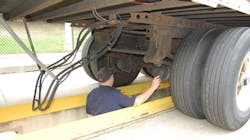CVSA Brake Safety Day results: 12% out of service
The Commercial Vehicle Safety Alliance (CVSA) held an unannounced Brake Safety Day on May 26 where commercial motor vehicle inspectors in Canada, Mexico and the U.S. conducted 10,091 inspections. CVSA revealed that 1,273 vehicles were placed out of service for brake-related critical vehicle inspection items.
Each year, for Brake Safety Day, CVSA-certified inspectors conduct inspections, focusing on the vehicle’s brake systems and components, and remove commercial motor vehicles with brake-related out-of-service violations from roadways. Here is a breakdown of the results:
- Six jurisdictions from Canada, 42 U.S. jurisdictions, and Mexico’s Ministry of Communications and National Guard participated.
- Inspectors in Canada, Mexico and the U.S. conducted 10,091 inspections and placed 1,273 vehicles out of service for brake violations.
- The brake-related out-of-service rate in North America was 12.6%.
- The U.S. brake-violation out-of-service rate was 13.3%. In Canada, the rate was 11.4% and in Mexico, the rate was 2.9%.
- In Canada, 946 inspections were conducted. In Mexico, inspectors conducted 487 inspections, and in the U.S., 8,658 inspections were conducted.
- Fourteen vehicles were removed from roadways in Mexico for brake violations. In Canada, 108 vehicles were placed out of service for brake violations, and in the U.S., 1,151 vehicles had to be removed from roadways due to brake violations.
In addition, inspectors compiled and reported data specifically on brake hoses/tubing, the focus area for this year’s Brake Safety Day. Canada, Mexico and the U.S. reported a total of 1,725 brake hoses/tubing violations from the one-day unannounced brake safety initiative. Broken out by country: Canada reported 251 chafing violations, Mexico reported 186 and the U.S. reported 1,288.
CVSA asked inspectors to submit data on five different brake hose/tubing chafing violations:
- Category 1 violations were defined as brake hose/tubing wear that had extended into the outer protective material. Thirty-eight percent (664) of brake hose chafing violations met that definition. This is not an out-of-service condition.
- A category 2 violation means wear had extended through the brake hose/tubing outer protective material into the outer rubber cover. Thirty percent (509) of brake hose chafing violations were category 2. Category 2 violations are not out-of-service conditions.
- When the brake hose/tubing wear makes the reinforcement ply visible, but the ply is still intact, that is a category 3 violation. Sixteen percent (275) of brake hose chafing violations were category 3. This is not an out-of-service condition.
- A category 4 violation is when the reinforcement ply is visible and the ply is completely frayed, severed or cut through. Ten percent (169) of brake hose chafing violations were category 4. Vehicles with category 4 chafed hose conditions were placed out of service.
- Brake hose/tubing wear for category 5 violations extended through the reinforcement ply to the inner rubber layer. Six percent (108) of brake hose chafing violations were identified as category 5, which is an out-of-service condition.
“Brake hoses and tubing are essential brake system components and must be properly attached, undamaged, without leaks and flexible,” John Samis, CVSA president and sergeant with the Delaware State Police, said. “We chose to focus on brake hoses/tubing this year in an effort to reduce deaths and injuries as a result of commercial motor vehicle brake-system failures from pressure or vacuum loss due to brake hose/tubing deficiencies.”
CVSA’s Brake Safety Week is scheduled for Aug. 22-28.


